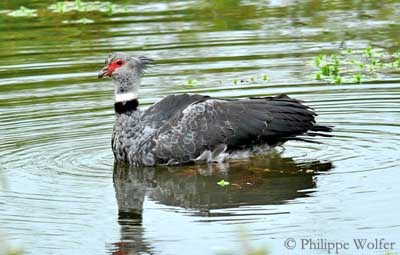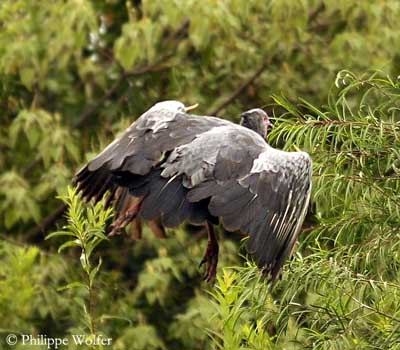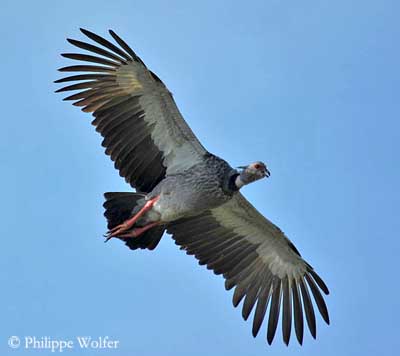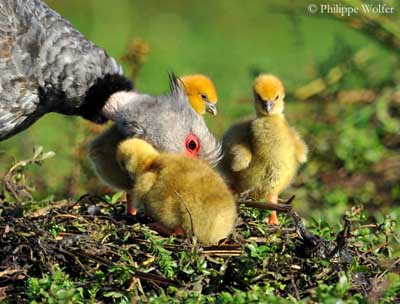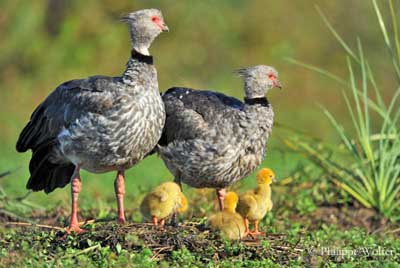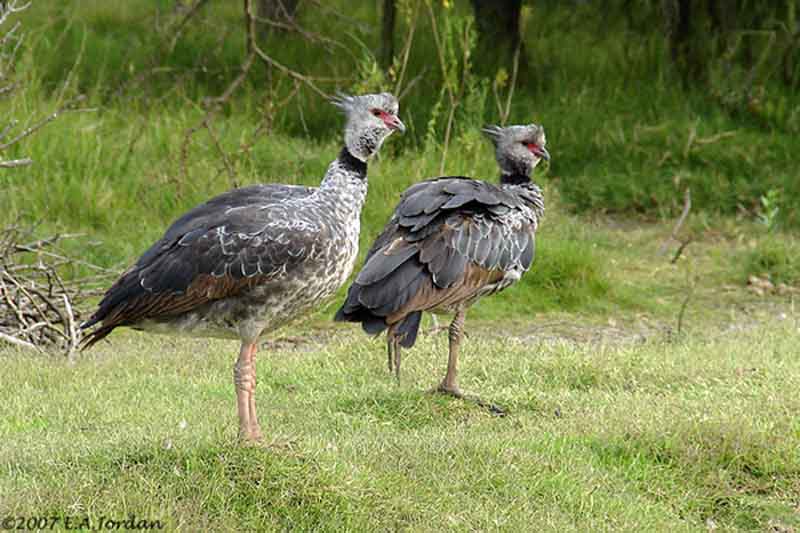
Southern Screamer
Chauna torquata
Anseriforme Order – Anhimidae Family
BIOMETRICS:
Length: 83-95 cm
Weight: 4 à 4, 5 kg
DESCRIPTION:
Screamers are walking and swimming birds very similar to geese. They have strong legs and a kind of vestigial web is still present between the long toes.
Southern Screamer adult has grey plumage overall. Upperparts are grey with dark grey wings and tail. On the wings, coverts are edged buffy-white, giving scaled effect. Flight feathers are dark grey. In flight, a large white patch is visible on primary coverts and flight feathers. There are two spurs protruding from the bend of each wing.
Underparts are paler grey with whitish edges, giving regular scaled effect. Underwing shows pale greyish coverts, and dark grey flight feathers, with white axillaries.
Head is grey. Forehead, crown and cheeks are pale grey. Upper neck and chin are darker grey. We can see a double neck-ring, white above and black below, more or less distinct according to the bird’s attitude. Hind crown shows grey fluffed crest often displayed.
Strong, down curved bill is horn-coloured to greyish. Lores, base of the bill and eye-ring are red and bare. Eyes are brown. Legs and feet are pinkish-red.
Both sexes are similar, with female slightly smaller than male.
Juvenile is duller than adults. It lacks the white neck-ring, and the black collar is indistinct. The spurs are short or absent.

Southern Screamer can be seen in large flocks of hundreds or thousands of birds outside the breeding season. They forage close to domestic animals and wander for food resources during winter.
Southern Screamers gather in large flocks at communal roosts, standing up in shallow water. They also rest in trees during long periods, often perched and very conspicuous at treetops.
If alarmed or threatened, Southern Screamer flies straight up into a tree, and utters loud alarm calls. It has two sharp, curved spurs on each wing, protruding from the bend of the wing. It uses them for fighting against rivals or predators, or during defence of its territory. These spurs are renewed regularly. Southern Screamer is able to fight against larger animals than it, and particularly against hunting dogs.
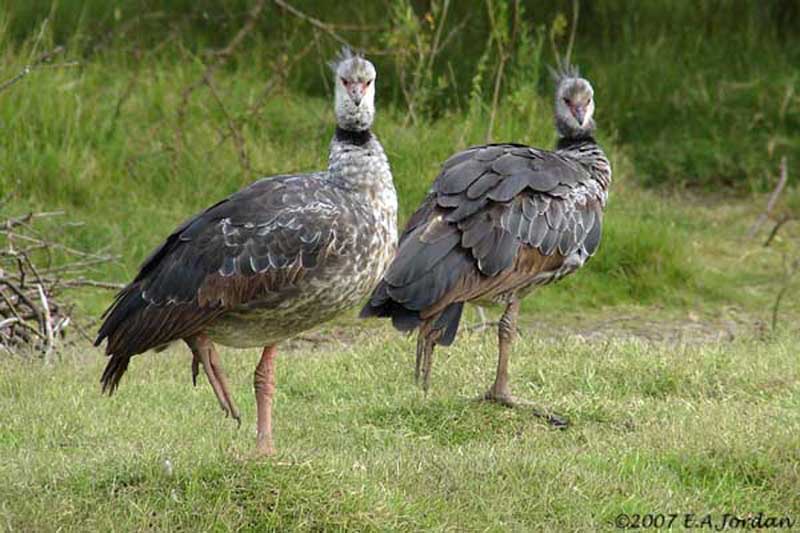
REPRODUCTION:
Breeding season occurs at any time of the year, with a peak during the austral spring, and laying in October-November.
Southern Screamer is solitary nester. The nest is built on the ground by both adults. It is located near water and very large. It is a mount of vegetation, such as reeds, weeds and sticks, and nest materials are collected around the nest-site. Located among vegetation and made with vegetal materials, this nest is almost invisible.
Female lays 3 to 5 white eggs, with pale spots. Incubation lasts about 43 to 46 days, shared by both parents. If both adults leave the nest, eggs are covered with vegetation.
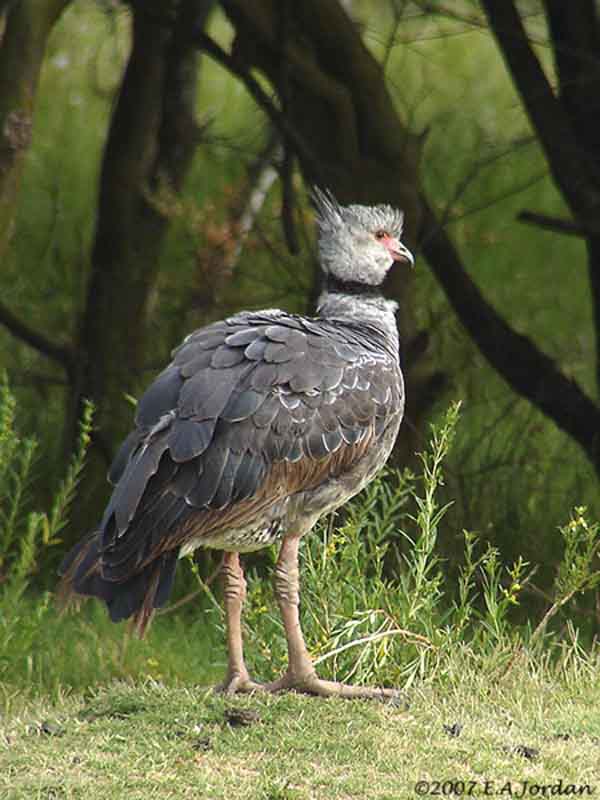
PROTECTION/THREATS/STATUS Southern Screamer is widespread and locally common in suitable intact habitat. It seems to be the most abundant of the three screamers’ species.
This species, as the two others, is threatened by degradation of the habitat and drainage of wetlands for agriculture extension. It is also a popular target for hunters.
However, at this moment, this species is not globally threatened.
Fr: Kamichi à collier
All : Halsband-Wehrvogel
Esp : Chajá Común
Ital : Palamedea fedele
Nd : Kuifhoenderkoet
Russe : Хохлатая паламедея
Photographers:
Eduardo Andrés Jordan
MIS AVES – AVES DE ARGENTINA
Philippe et Aline Wolfer
GALERIE
Text by Nicole Bouglouan
Sources :
HANDBOOK OF THE BIRDS OF THE WORLD vol 1 by Josep del Hoyo-Andrew Elliot-Jordi Sargatal - Lynx Edicions - ISBN: 8487334105
Wikipedia (Wikipedia, The Free Encyclopedia)
Arthur Grosset's Birds (Arthur Grosset)
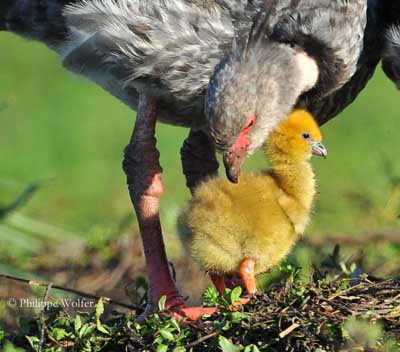
VOICE: SOUNDS BY XENO-CANTO
Southern Screamer utters very loud calls, often given in flight. They can be heard at 3 km away. They call all year round. They have powerful voice similar to trumpet-like sounds. The call is a harsh trumpeting call of two notes.
Southern Screamer produces other kind of sounds such as guttural noise, as drumming. This sound is used as threaten at close range, and it is not a vocal sound.
HABITAT:
Southern Screamer lives in wetlands such as flooded fields, meadows, marshes, lakes and lagoons. During winter, it frequents drier and agricultural areas.
RANGE:
Southern Screamer is found in Bolivia and southern Brazil to northern Argentina.
BEHAVIOUR:
Southern Screamer feeds on green parts of succulent aquatic vegetation, but also on seeds, stems and leaves of cultivated or not plants. It feeds by grazing as other Anseriformes. When grazing, it may be half submerged among vegetation in flooded areas. It also digs into the mud in shallow water.
